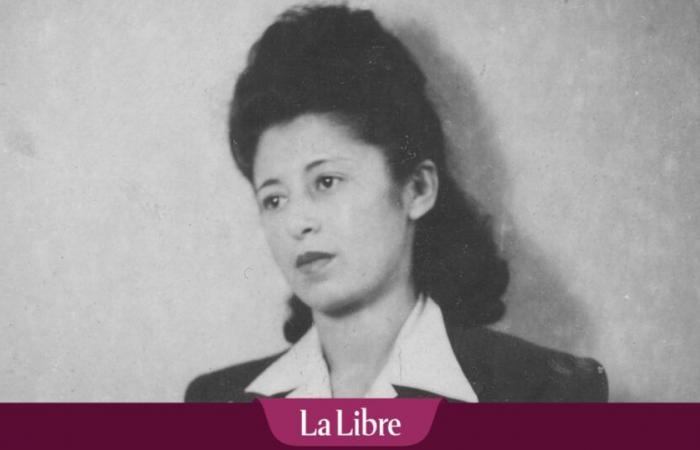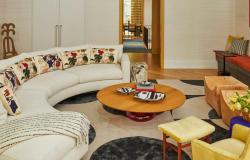Elisabeth Gérard is an architect; she is 25 years old and works for Bureau Suède 36 in Forest where she focuses on issues of inclusive public space planning. She is also part of L’Architecture qui dégenre, ABSL which has co-organized the Journées du Matrimoine for several years in the capital. Elisabeth Gérard will give two visits this Saturday, September 28, under the title Modernist villas by female architects in Uccle.
Digging up architect names
It all begins with an observation on his part. During his architecture classes at La Cambre, there is never any mention of a single Belgian female architect.At most, women were cited among the great contemporary architects…“Which does not fail to pique the curiosity of Elisabeth Gérard. Who decides to investigate. Zero articles, zero archive funds: “Perhaps because architecture was taught late as a university discipline? Because after all, from the end of the 19th century, there were many women doctors, women painters, women lawyers…“
She opens the student registers: there are indeed women enrolled at La Cambre, in the architecture department! From the 1930s. Yes, but why have they disappeared from the face of the Earth, nowhere to be found in our sight? Especially since, as we understand from the title of her visit – Modernist villas by female architects in Uccle –, female architects have indeed made an artistic gesture that remains.”I decided to focus on the first nine women to graduate from La Cambre in architecture (Claire Henrotin, Margarethe Raemaekers, Ora Fradis, Dita Roque-Gourary, Simone Guillissen-Hoa, Monique De Koninck, Françoise Colsoulle, Françoise Van Cauwenberghe and Odette Filippone, Editor’s note).
“And they all have a particular genealogy, several are daughters of engineers or architects.” Françoise Colsoulle’s mother studied medicine in Glasgow, Claire Henrotin is the granddaughter of the Belgian painter Marie Collart. The prerequisite for being an architect in the 30s, 40s, 50s was to have a family of intellectuals, steeped in progressive thought.
OK, but once they graduate, how do they make themselves known, especially since they are an exception in a man’s world? We dare to ask the awkward question: if they are chosen, at the time, by clients to design their villas, is it because they cost less, because of their status as women architects? During her investigation, Elisabeth Gérard did not find any fee notes, however, she came across this reminder letter from one of them to a client: “I already cost you less than a man.…” Our researcher adds: “Even though they were brilliant students and distinguished themselves in their studies, all of them began their careers alongside a man.. A father or a husband, Monique De Koninck with her father Louis, and Odette Filipponewith her husband.”
Modern girls
And if their professional debuts were made with the support of a man, they quickly took their full independence and in particular stylistic. These women architects chose to assert the new stylistic current of the time, modernism, then in complete opposition to the more traditional current of historicism – also called façadism.It is important to point out that La Cambre is one of the first universities to teach this modernist style, whose key word is rationality. However, this state of affairs has been used against women themselves. In fact, this movement was considered virile because it was rational. And, as you know, women are not rational beings, and they are much better at embellishments….” (laughs).
All of them, therefore, began an intense career, which almost none of them interrupted for family reasons. We think of Simone Guillissen-Hoa who was a single mother and an active architect. The former resistance fighter found some of her clients in the old resistance network and in communist circles; Françoise Van Cauwenberghe, for her part, via the Catholic network.She left for Rwanda in the colonial context and worked for a bishop“. And although these nine women are not of the same political persuasion,”each draws on its political networks“.
We will take the time to revisit the exhibition dedicated to Simone Guillissen Hoa, at CIVA, until September 22.
The posterity of the genre
Is there a feminist signature among female architects? For Elisabeth Gérard, this question is “ambiguous“. Commentators at the time had already wanted to speak of a “delicate feminine style”, and that, clearly, is just a gender bias.” Understand a good old prejudice.”On the other hand, we can imagine that women architects tend to build by putting themselves in the shoes of the women who will occupy the house. I am thinking in particular of Claire Henrotin, who has become an expert in kitchen design, who says in one of her writings: : “the most exhausting job in the world is surely that of a mother”. For example, she invented, in one of the villas of Fond Roy, a low door to the kitchen which allows the children to be watched while preparing the meal.This is all the more interesting because she herself had no children.”. Simone Guillissen-Hoa designs bay windows with small balconies, to facilitate, she says, the cleaning of the windows. All this was noted by Appolline Vrancken, architect and founding member of L’architecture qui dégenre, who then speaks of a “female gaze” in architecture, a concept that questions the way we look at women, protagonists or, here, users of architecture. The female gaze in architecture therefore exists, less in a gendered stylistic signature, but rather in the architect’s drawing. This is what we observe in the housing plans imagined by Simone Guillissen-Hoa which include playrooms for children.It integrates children, who are often made invisible, as users in architecture.
Elisabeth Gérard gives us another pear for the thirst, by quoting contemporary architect Susana TORRO. The latter refutes the existence of a feminine style in architecture but underlines that women architects more often tend to apply the specific requests of their clients, beyond their own architectural program, thus going beyond the question of the creator’s ego.
Finally, if these women architects are not all of the same political movement, it is striking, for the researcher Elisabeth Gérard, to realize that all have been active at the activist level. Sitting at the National Council of Belgian Women, or within the Federation of Liberal Women. In the National Council Bulletinseveral of them recall the importance of nurseries and playgrounds at the local level. “Their ambitions as architects are clearly also on a city scale.”
“What’s funny – or confusing, your choice –, concludes Elisabeth Gérard, is that we feminist architects have, at the present time, still exactly the same demands“.
⇒ Matrimoine Days, from September 27 to 29, in Brussels. Info and reservations: https://www.matrimonydays.be. Please note that if Elisabeth Gérard’s visit is already full, this tour will be on the program for the Matrimoine season, starting in November. More information to follow on www.architecturequidegenre.be
⇒ Free daycare on request for children aged 4 to 10 is offered during the Matrimoine Days weekend at the Bruegel cultural centre. Send us your request to [email protected]
⇒ Also on view at Civa, until September 22, is an exhibition dedicated to Simone Guillissen-Hoa. Info https://civa.brussels/fr






